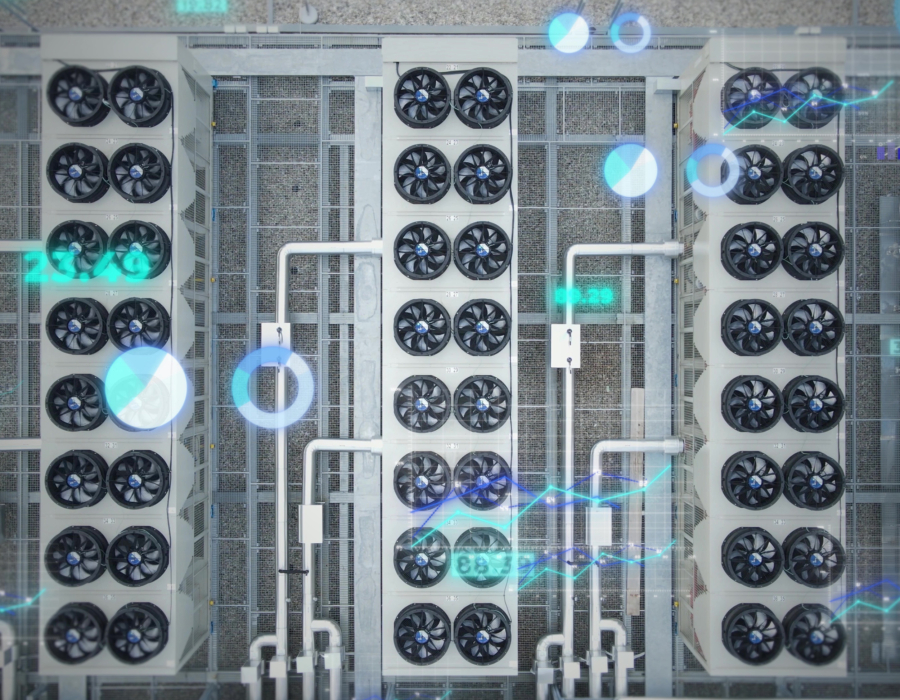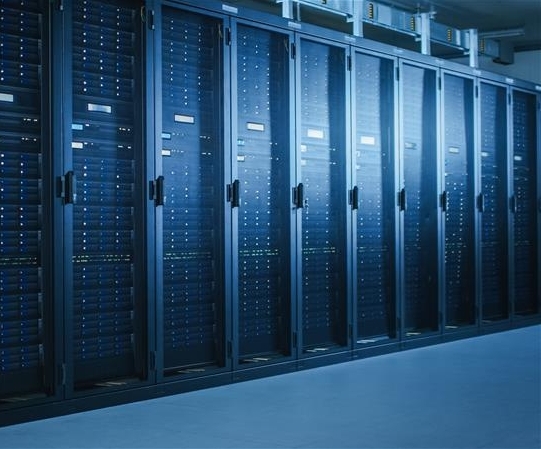Our industry is engaged in an important dialogue to improve the efficiency and resilience of real assets through transparency and industry collaboration. This article is a contribution to this larger conversation and does not necessarily reflect GRESB’s position.
The EMEA data center market outpaces global trends
In an era of rapid digital transformation, data centers have emerged as the backbone of our increasingly connected world with the global market continuing to experience phenomenal growth.
Driven by the rapid adoption of AI and cloud computing, the EMEA data center market is projected to achieve an exceptional 25% CAGR over the next three years, surpassing the global market’s 15% CAGR through 2027 (JLL, EMEA Data center Report Q4 2024, p.6). This surge is particularly evident in the FLAP-D markets (Frankfurt, London, Amsterdam, Paris, Dublin), where pre-leasing activities nearly doubled in 2024, reaching 702MW (JLL, EMEA Data center Report Q4 2024, p.6).
This trend is transforming both real estate and technology, reshaping investment portfolios and redefining the real estate landscape as capital expenditure flows into this rapidly growing sector. However, this growth is placing unprecedented demand on power infrastructure, creating a new set of challenges for the industry and policymakers alike. In response, countries across EMEA are implementing innovative solutions to manage energy consumption and grid capacity as well as racing to ensure legislation is keeping pace with market developments.
Investors and operators must adapt to new regulatory landscapes, integrate advanced due diligence frameworks, and balance growth with environmental responsibility to ensure long-term success in this critical sector.
For more on EMEA data center market trends, please see JLL’s EMEA Data center Report Q4 2024: AI drives generational growth in data centers across Europe.
Germany leads the charge for sustainable data center regulations
While the EMEA region grapples with the challenges of rapid growth and its associated energy demands, Germany has taken a significant step in addressing the environmental impact of digital expansion, becoming the first country to transpose the EU Energy Efficiency Directive (EED) Article 15 through the German Energy Efficiency Act (EnEFG). This landmark legislation sets stringent expectations for data center energy efficiency and reporting, including:
- Mandating 100% renewable energy use for data centers from 2027.
- Requiring new data centers starting operation from July 2026 to achieve a Power Use Effectiveness (PUE) of 1.2.
- Setting specific targets for Energy Reuse Factor (ERF), with new facilities from July 2026 required to achieve an ERF of 10%.
- Requiring all data center operators in Germany to implement an energy or environmental management system by July 1, 2025, with those above a certain capacity required to validate/certify their system by July 1, 2026.
As other European countries follow suit, data center operators and investors will need to adapt to new regulatory landscapes, requiring innovation in sustainable design and operation and collaboration between landlords and tenants to meet stringent targets.
Germany’s approach may serve as a blueprint for other nations, reshaping the European regulatory landscape and establishing new benchmarks for sustainable operation. As the industry evolves, early adopters stand to gain a competitive advantage in an increasingly sustainability compliance-and disclosure-focused market.
How are investors adapting to the data center boom? A case study in ESG framework and due diligence evolution
As data centers become increasingly integrated into real estate portfolios, investors are facing a complex set of challenges, requiring the navigation of a new asset class that demands an overhaul of investment strategies, due diligence processes, and operational understanding. Investors must therefore work with an evolving regulatory landscape, to understand intricate technical aspects of data centers, and to familiarize themselves with industry-specific standards and frameworks.
One of JLL’s clients, a major European real estate investment firm, recently faced this challenge. Having traditionally focused on office and retail properties but recognizing the need to diversify into the data center sector, they quickly realized their existing ESG framework was inadequate for assessing the distinct sustainability issues associated with digital infrastructure assets.
JLL assisted the client in developing a comprehensive ESG framework tailored for data center investments. This framework incorporated:
- Mandatory requirements aligned with new regulations, such as Germany’s Energy Efficiency Act (EnEfG), which sets specific targets for PUE and renewable energy use.
- Best practices from industry standards like the EU Code of Conduct for Data centers and the Climate Neutral Data center Pact.
- Key Performance Indicators (KPIs) based on ISO/EN standards, including Renewable Energy Factor (REF), PUE, Water Usage Effectiveness (WUE), and ERF.
- Consideration of emerging sustainability metrics such as Carbon Usage Effectiveness (CUE), Cooling Efficiency (CER), and IT Equipment Energy Efficiency/Utilization for Servers (ITEEsv/ITEUsv).
- Integration of climate risk assessments and circular economy principles in line with EU “Do No Significant Harm” (DNSH) criteria.
- Alignment with SFDR Article 8 reporting requirements, including specific environmental characteristics and Principal Adverse Impact indicators.
By translating complex technical and regulatory information into practical frameworks, investors can effectively navigate the complexities of this new asset class. This approach allows them to stay ahead of regulatory changes, such as the upcoming EU Sustainability Rating Scheme for Data centers, and market trends in the sector. It also positions them to make more informed investment decisions, better manage risks, and potentially access green financing opportunities.
Can emerging technologies meet the sustainability challenge of modern data centers?
Emerging technologies in the data center sector are playing a crucial role in addressing sustainability challenges. These innovations are positioning forward-thinking operators and investors ahead of regulatory changes and at the forefront of sustainable data center operations.
-
Increasing energy demand and carbon emissions
The challenge: The rapid adoption of AI and machine learning workloads has led to an unprecedented demand on global power grids; estimations anticipate that European electricity demand from data centers could double by 2030, reaching 945 TWh (IEA 2025).The potential solutions: To meet this growing demand sustainably, Small Modular Reactors (SMRs) illustrate a cost-effective, low-carbon energy solution. Operators such as AWS and Google have reportedly signed Power Purchase Agreements with SMR developers (Google 2025; Amazon 2025), particularly in the United States. In Europe, Brookfield-owned Data4 is exploring SMR use across their facilities (Data Center Dynamics 2025). Furthermore, the European Parliament supports SMRs through the European Industrial Alliance on SMRs, targeting early 2030s deployment (European Commission 2025). While SMRs offer potential as a sustainable and reliable power source for data centers, their adoption faces significant challenges, namely through risks of delays and cost overruns associated with innovative technology integration, alongside widespread public and governmental concerns about utilizing nuclear technology. To gain broader support, the industry must address these challenges through transparent communication, robust safety measures, and demonstrated cost-effectiveness.
-
Traditional on-site energy generation
The challenge: Diesel generators have been used in data centers as a form of backup generation since the inception of “traditional” data centers, providing a reliable method for mitigating downtime risks.
The potential solutions: Some operators are transitioning to Hydrotreated Vegetable Oil (HVO) as a form of fuel, offering an attractive reduction in direct CO2 emissions, as a replacement for standard diesel. Additionally, Battery Energy Storage Systems (BESS) and Long Duration Energy Storage (LDES) are being explored as alternatives to traditional diesel generators for backup power. Advancements in battery technology, such as liquid metal batteries, are making these systems increasingly viable. However, unlike traditional fossil fuel-based energy generation, in the scenario of an extended grid outage, a battery storage system cannot be replenished with fuel under an emergency fuel contract to continue operations. Therefore, a combination of both generators may be more likely, using HVO fuel and a form of battery storage to handle short-term outages or grid instability. -
Cooling efficiency and water usage
The challenge: Water consumption in data center cooling has faced increasing scrutiny. In 2021, Google’s data centers alone consumed approximately 4.3 billion gallons of water (Google 2025).
The potential solutions: With WUE and PUE becoming key metrics for measurement and reporting and environmental impact on water sources being scrutinized in voluntary ESG initiatives, data centers must take into consideration the efficiency of their cooling design and the expected consumption of water within the chosen mechanical cooling technology. For example, Direct-to-Chip (DTC) and immersion cooling offer significant improvements in cooling efficiency, while advancements in dry cooling technologies are also gaining traction due to their positive impact on WUE, significantly reducing or eliminating water usage in cooling systems.
Future outlook: As the industry evolves, next-generation computing technologies (i.e., quantum, photonic, and neuromorphic computing) may fundamentally alter data center design and operation. While still in early stages, these technologies promise exponential increases in computing power with potentially lower energy requirements, which could revolutionize data center sustainability metrics.
GRESB is evolving to capture data center sustainability
GRESB is taking significant steps to address the unique sustainability challenges faced by the data center sector, partnering with iMasons to launch a dedicated Data Center Working Group. This initiative aims to develop a tailored assessment solution, addressing the sector’s specific energy use patterns, stakeholder relationships, and performance metrics. From 2026, GRESB and iMasons plan to introduce new assessment options that will complement existing standards while providing more sector-specific indicators, metrics, and weights. This evolution in sustainability reporting reflects the growing importance of data centers in the real estate landscape and the industry’s commitment to addressing its unique environmental challenges.
For further analysis of trends and strategic recommendations for 2025 GRESB data center participants, read: Navigating Data center Sustainability with GRESB.
Glossary
BESS | Battery Energy Storage System: Systems utilising batteries to store electricity.
CAGR | Compound Annual Growth Rate.
Climate Neutral Data center Pact | A pledge of European cloud infrastructure and data center players aiming to achieve climate neutrality by 2030.
CUE | Carbon Usage Effectiveness: Measures the carbon emissions of a data center relative to its IT energy consumption.
DNSH | Do No Significant Harm: A principle in EU regulations ensuring that economic activities do not negatively impact environmental objectives.
EED | EU Energy Efficiency Directive: An EU form of legislation used to promote energy efficiency across various sectors.
ERF | Energy Reuse Factor: A metric used to measure the amount of energy used in a data center that is reused for purposes outside the data center’s primary operations.
Immersion Cooling | Systems encompassing electronic components directly exposed to and interacting with dielectric fluids for cooling.
ITEE | IT Equipment Energy Efficiency: Measures the energy efficiency of IT equipment in data centers.
LDES | Long Duration Energy Storage: Storage systems capable of delivering electricity for 10+ hours in duration.
Neuromorphic Computing | An approach to computing inspired by the structure and function of the human brain.
Photonic Computing | Utilises light (photons) instead of electrons to perform computations.
PUE | Power Usage Effectiveness: A ratio measuring data center energy efficiency. Lower values closer to 1.0 are better.
Quantum Computing | A computer that exploits quantum mechanical phenomena.
REF | Renewable Energy Factor: A metric used to measure the percentage of renewable energy used in a data center’s total electricity consumption.
SMR | Small Modular Reactor: Nuclear reactors designed for modular construction, generally with a power output of 300 MWe per unit.
WUE | Water Usage Effectiveness: Measures the amount of water used per unit of IT equipment energy. Lower values indicate more efficient water use.
References
Amazon. “Amazon enlists nuclear small modular reactors in push for net carbon-zero.” Accessed May 15, 2025. https://www.aboutamazon.com/news/sustainability/amazon-nuclear-small-modular-reactor-net-carbon-zero
Data Center Dynamics. “Data4 signs nuclear SMR deal with Westinghouse.” Accessed May 15, 2025. https://www.datacenterdynamics.com/en/news/data4-signs-nuclear-smr-deal-with-westinghouse/
European Commission. “European Industrial Alliance on Small Modular Reactors.” Accessed May 15, 2025. https://single-market-economy.ec.europa.eu/industry/industrial-alliances/european-industrial-alliance-small-modular-reactors_en
Google Blog. “Google and Kairos Power Nuclear Energy Agreement.” Accessed May 15, 2025. https://blog.google/outreach-initiatives/sustainability/google-kairos-power-nuclear-energy-agreement/
Google Blog. “Our Commitment to Climate-Conscious Data Center Cooling.” Accessed May 15, 2025. https://blog.google/outreach-initiatives/sustainability/our-commitment-to-climate-conscious-data-center-cooling/
IEA. “AI is set to drive surging electricity demand from data centres while offering the potential to transform how the energy sector works.” Published April 10, 2025. Accessed May 15, 2025. https://www.iea.org/news/ai-is-set-to-drive-surging-electricity-demand-from-data-centres-while-offering-the-potential-to-transform-how-the-energy-sector-works
JLL. EMEA Data Centre Report Q4 2024: AI Drives Generational Growth in Data Centres Across Europe. Accessed May 15, 2025. https://www.jll.co.uk/en/trends-and-insights/research/emea-data-centre-report
This article was written by Beth Peachey, Sustainability Consultant (JLL EMEA Sustainability Consulting) and Ross Smyth, Senior Consultant (JLL EMEA Data Centre Consulting). Learn more about JLL here.


